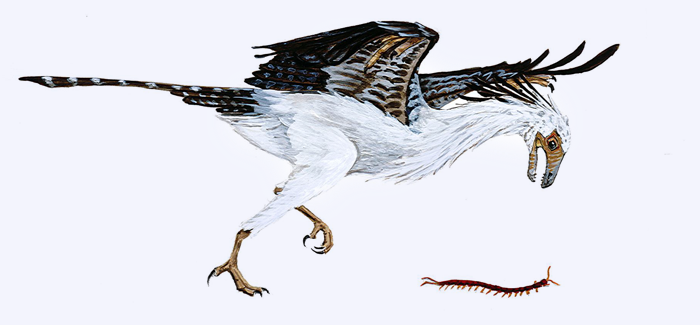
Jeholornis (shown above), a primitive bird, lived during the early Cretaceous period approximately 120 million years ago. The evolution of Jeholornis and other Cretaceous birds is the subject of a new paper published in the Proceedings of the Royal Society B. (Illustration courtesy Allison Elaine Johnson)
Earth’s earliest birds show a strikingly narrow range of diversity, sleepless mothers pass on metabolic problems to their offspring, and early-childhood programs show benefits in Jamaica.
A little bird
When birds first emerged more than 125 million years ago, the range of diversity was strikingly narrower than today. “They were pretty much all between a sparrow and a crow,” says Jonathan Mitchell, a PhD student in UChicago’s Committee on Evolutionary Biology and lead author of a study on early Cretaceous birds, published May 28 in Proceedings of the Royal Society B. With Field Museum paleontologist Peter Makovicky, Mitchell analyzed fossils collected from an area in China where they were preserved in abundance by volcanoes. Some birds, the researchers found, had teeth and long bony tails; nearly all were small ground or forest dwellers that lived on insects and seeds. Particularly lacking were large birds and water birds. Diversity could have been hampered by competition from similar animals, such as flying reptiles called pterosaurs, but might also be explained by the fact that birds had not existed long enough to diversify widely.
Rockabye mother
Poor sleep during the third trimester of pregnancy—a serious problem for some women, especially with sleep apnea—means a higher risk of weight gain and metabolic abnormalities for offspring once they reach adulthood, according to a study published online May 8 in Diabetes and led by UChicago pediatrician and sleep specialist David Gozal. Researchers tested the effects of fragmented sleep in pregnant mice. As newborns, the offspring of mothers whose rest had been disturbed (by a motorized brush sweeping through their cages every two minutes) grew normally. But at the equivalent of early middle age, these offspring began eating more and gaining excess weight, ending up 10 percent heavier than mice whose mothers had slept uninterrupted. They also scored poorly on glucose-tolerance tests and produced less effective insulin. The researchers determined that a mother’s sleep loss reduces her offspring’s expression of the gene for adiponectin, a hormone that helps regulate metabolic processes.
Growth investment
The long-term cognitive and economic benefits of early-childhood nutritional and emotional development programs in the United States also hold true in developing nations. Results of a study led by UChicago economist James J. Heckman and the University of California, Berkeley’s Paul Getler, published May 30 in Science, showed the impact of interventions in Jamaica. Heckman and Getler interviewed subjects who had been enrolled in the study as toddlers in 1986 and 1987. They were selected then based on diagnoses of stunted growth and poor cognitive development, which are associated with malnutrition. The treatment group received nutritional and educational support and their parents learned child-rearing skills and interaction techniques to improve their children’s cognitive and socioemotional development. This approach, Heckman and Getler found, increased the adult earnings of participants, who are now almost 30 years old, by 25 percent—enough to equal a comparison group whose development had not been stunted.
